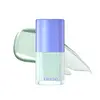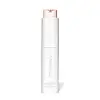What's inside
What's inside
 Key Ingredients
Key Ingredients

 Benefits
Benefits

 Concerns
Concerns

 Ingredients Side-by-side
Ingredients Side-by-side

Water
Skin ConditioningGlycerin
HumectantMethyl Trimethicone
Skin ConditioningOctyldodecyl Stearoyl Stearate
EmollientPentaerythrityl Stearate/Caprate/Caprylate/Adipate
EmollientCI 77891
Cosmetic ColorantHydrogenated Polydecene
EmollientPentylene Glycol
Skin Conditioning1,2-Hexanediol
Skin ConditioningHydrogenated Olive Oil
Skin ConditioningOlea Europaea Fruit Oil
MaskingOlea Europaea Oil Unsaponifiables
Skin ConditioningOpuntia Coccinellifera Fruit Extract
Skin ConditioningSodium Hyaluronate
HumectantChitosan
Hydrolyzed Hyaluronic Acid
HumectantHyaluronic Acid
HumectantPolymethylsilsesquioxane
Trimethylsiloxysilicate
EmollientAmmonium Acryloyldimethyltaurate/Vp Copolymer
Betaine
HumectantBisabolol
MaskingIsododecane
EmollientPotassium Cetyl Phosphate
EmulsifyingHydroxyethyl Acrylate/Sodium Acryloyldimethyl Taurate Copolymer
Emulsion StabilisingSorbitan Sesquioleate
EmulsifyingPanthenol
Skin ConditioningGlyceryl Caprylate
EmollientSilica
AbrasiveC12-20 Alkyl Glucoside
EmulsifyingAluminum Hydroxide
EmollientSodium Acrylate/Sodium Acryloyldimethyl Taurate Copolymer
Emulsion StabilisingTriethoxycaprylylsilane
Polyisobutene
Adenosine
Skin ConditioningTrisodium Ethylenediamine Disuccinate
Caprylyl/Capryl Glucoside
CleansingSorbitan Oleate
EmulsifyingBeta-Glucan
Skin ConditioningButylene Glycol
HumectantDipropylene Glycol
HumectantPropanediol
SolventHydrogenated Lecithin
EmulsifyingCholesterol
EmollientBenzyl Glycol
SolventHydrolyzed Glycosaminoglycans
HumectantCeramide NP
Skin ConditioningHydroxypropyltrimonium Hyaluronate
Sodium Hyaluronate Crosspolymer
HumectantEthylhexylglycerin
Skin ConditioningSodium Acetylated Hyaluronate
HumectantHydrolyzed Sodium Hyaluronate
Skin ConditioningPotassium Hyaluronate
Skin ConditioningC14-22 Alcohols
Emulsion StabilisingCetearyl Alcohol
EmollientParfum
MaskingAlpha-Isomethyl Ionone
PerfumingLinalool
PerfumingCI 77288
Cosmetic ColorantWater, Glycerin, Methyl Trimethicone, Octyldodecyl Stearoyl Stearate, Pentaerythrityl Stearate/Caprate/Caprylate/Adipate, CI 77891, Hydrogenated Polydecene, Pentylene Glycol, 1,2-Hexanediol, Hydrogenated Olive Oil, Olea Europaea Fruit Oil, Olea Europaea Oil Unsaponifiables, Opuntia Coccinellifera Fruit Extract, Sodium Hyaluronate, Chitosan, Hydrolyzed Hyaluronic Acid, Hyaluronic Acid, Polymethylsilsesquioxane, Trimethylsiloxysilicate, Ammonium Acryloyldimethyltaurate/Vp Copolymer, Betaine, Bisabolol, Isododecane, Potassium Cetyl Phosphate, Hydroxyethyl Acrylate/Sodium Acryloyldimethyl Taurate Copolymer, Sorbitan Sesquioleate, Panthenol, Glyceryl Caprylate, Silica, C12-20 Alkyl Glucoside, Aluminum Hydroxide, Sodium Acrylate/Sodium Acryloyldimethyl Taurate Copolymer, Triethoxycaprylylsilane, Polyisobutene, Adenosine, Trisodium Ethylenediamine Disuccinate, Caprylyl/Capryl Glucoside, Sorbitan Oleate, Beta-Glucan, Butylene Glycol, Dipropylene Glycol, Propanediol, Hydrogenated Lecithin, Cholesterol, Benzyl Glycol, Hydrolyzed Glycosaminoglycans, Ceramide NP, Hydroxypropyltrimonium Hyaluronate, Sodium Hyaluronate Crosspolymer, Ethylhexylglycerin, Sodium Acetylated Hyaluronate, Hydrolyzed Sodium Hyaluronate, Potassium Hyaluronate, C14-22 Alcohols, Cetearyl Alcohol, Parfum, Alpha-Isomethyl Ionone, Linalool, CI 77288
Water
Skin ConditioningPropanediol
SolventGlycerin
HumectantTricaprylin
MaskingDipropylene Glycol
Humectant1,2-Hexanediol
Skin ConditioningPolyglyceryl-3 Distearate
EmulsifyingPolyurethane-15
Betaine
HumectantSodium Acrylate/Sodium Acryloyldimethyl Taurate Copolymer
Emulsion StabilisingAcrylates/C10-30 Alkyl Acrylate Crosspolymer
Emulsion StabilisingGlyceryl Stearate
EmollientCetearyl Alcohol
EmollientTromethamine
BufferingPolyisobutene
Synthetic Fluorphlogopite
Hyaluronic Acid
HumectantEthylhexylglycerin
Skin ConditioningGlyceryl Stearate Citrate
EmollientMica
Cosmetic ColorantSorbitan Oleate
EmulsifyingCaprylyl/Capryl Glucoside
CleansingCitrus Aurantium Bergamia Fruit Oil
MaskingOlea Europaea Fruit Oil
MaskingSqualane
EmollientCitrus Aurantium Dulcis Peel Oil
MaskingTin Oxide
AbrasiveSolanum Melongena Fruit Extract
Skin ConditioningLavandula Angustifolia Oil
MaskingJuniperus Virginiana Oil
MaskingPelargonium Graveolens Flower Oil
MaskingDisodium Acetyl Glucosamine Phosphate
Skin ConditioningCopaifera Officinalis Resin
MaskingSodium Glucuronate
HumectantMagnesium Sulfate
Myrtus Communis Oil
MaskingArtemisia Vulgaris Oil
PerfumingRosa Damascena Flower Oil
MaskingFerula Galbaniflua Resin Oil
AntimicrobialLimonene
PerfumingLinalool
PerfumingCI 77891
Cosmetic ColorantCI 77491
Cosmetic ColorantWater, Propanediol, Glycerin, Tricaprylin, Dipropylene Glycol, 1,2-Hexanediol, Polyglyceryl-3 Distearate, Polyurethane-15, Betaine, Sodium Acrylate/Sodium Acryloyldimethyl Taurate Copolymer, Acrylates/C10-30 Alkyl Acrylate Crosspolymer, Glyceryl Stearate, Cetearyl Alcohol, Tromethamine, Polyisobutene, Synthetic Fluorphlogopite, Hyaluronic Acid, Ethylhexylglycerin, Glyceryl Stearate Citrate, Mica, Sorbitan Oleate, Caprylyl/Capryl Glucoside, Citrus Aurantium Bergamia Fruit Oil, Olea Europaea Fruit Oil, Squalane, Citrus Aurantium Dulcis Peel Oil, Tin Oxide, Solanum Melongena Fruit Extract, Lavandula Angustifolia Oil, Juniperus Virginiana Oil, Pelargonium Graveolens Flower Oil, Disodium Acetyl Glucosamine Phosphate, Copaifera Officinalis Resin, Sodium Glucuronate, Magnesium Sulfate, Myrtus Communis Oil, Artemisia Vulgaris Oil, Rosa Damascena Flower Oil, Ferula Galbaniflua Resin Oil, Limonene, Linalool, CI 77891, CI 77491
 Reviews
Reviews

Ingredients Explained
These ingredients are found in both products.
Ingredients higher up in an ingredient list are typically present in a larger amount.
1,2-Hexanediol is a synthetic liquid and another multi-functional powerhouse.
It is a:
- Humectant, drawing moisture into the skin
- Emollient, helping to soften skin
- Solvent, dispersing and stabilizing formulas
- Preservative booster, enhancing the antimicrobial activity of other preservatives
Betaine is a common humectant (a substance that promotes retention of moisture). It's known to be gentle on the skin and can help balance hydration.
This ingredient is best for improving hydration and soothing irritated skin. Studies also show it helps even out skin tone.
Fun fact: Betaine is naturally created in the skin and body. The kind found within cosmetic products can be either plant-derived or synthetic.
Another name for betaine is trimethylglycine.
Learn more about BetaineCaprylyl/Capryl Glucoside is an alkyl glucoside. This just means it is creating by reacting alcohol and sugar. It is a cleansing and foaming ingredient.
Caprylyl/Capryl Glucoside helps remove the dirt, oil, and other pollutants from your skin.
Cetearyl alcohol is a mixture of two fatty alcohols: cetyl alcohol and stearyl alcohol. It is mainly used as an emulsifier. Emulsifiers help prevent the separation of oils and products. Due to its composition, it can also be used to thicken a product or help create foam.
Cetearyl alcohol is an emollient. Emollients help soothe and hydrate the skin by trapping moisture.
Studies show Cetearyl alcohol is non-toxic and non-irritating. The FDA allows products labeled "alcohol-free" to have fatty alcohols.
This ingredient is usually derived from plant oils such as palm, vegetable, or coconut oils. There is debate on whether this ingredient will cause acne.
Due to the fatty acid base, this ingredient may not be Malassezia folliculitis safe.
Learn more about Cetearyl AlcoholCi 77891 is a white pigment from Titanium dioxide. It is naturally found in minerals such as rutile and ilmenite.
It's main function is to add a white color to cosmetics. It can also be mixed with other colors to create different shades.
Ci 77891 is commonly found in sunscreens due to its ability to block UV rays.
Learn more about CI 77891Dipropylene Glycol is a synthetically created humectant, stabilizer, and solvent.
This ingredient helps:
Dipropylene glycol is technically an alcohol, but it belongs to the glycol family (often considered part of the ‘good’ alcohols). This means it is hydrating and gentle on skin unlike drying solvent alcohols like denatured alcohol.
As a masking agent, Dipropylene Glycol can be used to cover the smell of other ingredients. However, it does not have a scent.
Studies show Dipropylene Glycol is considered safe to use in skincare.
Learn more about Dipropylene GlycolEthylhexylglycerin (we can't pronounce this either) is commonly used as a preservative and skin softener. It is derived from glyceryl.
You might see Ethylhexylglycerin often paired with other preservatives such as phenoxyethanol. Ethylhexylglycerin has been found to increase the effectiveness of these other preservatives.
Glycerin is already naturally found in your skin. It helps moisturize and protect your skin.
A study from 2016 found glycerin to be more effective as a humectant than AHAs and hyaluronic acid.
As a humectant, it helps the skin stay hydrated by pulling moisture to your skin. The low molecular weight of glycerin allows it to pull moisture into the deeper layers of your skin.
Hydrated skin improves your skin barrier; Your skin barrier helps protect against irritants and bacteria.
Glycerin has also been found to have antimicrobial and antiviral properties. Due to these properties, glycerin is often used in wound and burn treatments.
In cosmetics, glycerin is usually derived from plants such as soybean or palm. However, it can also be sourced from animals, such as tallow or animal fat.
This ingredient is organic, colorless, odorless, and non-toxic.
Glycerin is the name for this ingredient in American English. British English uses Glycerol/Glycerine.
Learn more about GlycerinHyaluronic acid is naturally found in healthy skin. It is a humectant, meaning it draws moisture to your skin.
This ingredient helps hydrate, soothe, and protect the skin.
What makes hyaluronic acid so hydrating? It has the capacity to bind or hold large amounts of water.
Fun fact: It is already naturally found in our bodies, such as the fluids of our eyes and our joints.
Studies find this ingredient to have anti-inflammatory and anti-microbial properties. This can help speed up wound-healing.
Hyaluronic acid can be irritating if the molecule has a low-molecular weight, or if the molecules are small.
One study found low-molecular weight hyaluronic acid to be pro-inflammatory, meaning some people may experience irritation. This is because our bodies use hyaluronic acid in the wound-healing process to signal to our bodies, via irritation, that something needs healing.
The same study found high-molecular weight hyaluronic acid to be anti-inflammatory.
These are some other common types of Hyaluronic Acid:
Learn more about Hyaluronic AcidLinalool is a fragrance and helps add scent to products. It's derived from common plants such as cinnamon, mint, citrus, and lavender.
Like Limonene, this ingredient oxidizes when exposed to air. Oxidized linalool can cause allergies and skin sensitivity.
This ingredient has a scent that is floral, spicy tropical, and citrus-like.
Learn more about LinaloolOlea Europaea Fruit Oil is the fixed oil obtained from the ripe fruit of the Olive. In other words - olive oil.
The primary contents of olive oil are glycerides of the fatty acids linoleic, oleic and palmitic.
Olive oil also contains antioxidants such as Vitamin E. Antioxidants may help reduce signs of aging by fighting unstable free-radical molecules. It also contains Vitamins A (retinol), D, and K.
The squalene in olive oil makes it a great emollient. Emollients help soothe and soften your skin by trapping moisture in. This makes olive oil a great skin moisturizer.
Studies show olive oil to have antibacterial and antifungal properties in low concentrations. Another study found olive oil irritated sensitive oily skin. We always recommend speaking with a professional about using this ingredient in your routine.
Due to the fatty acid content, this ingredient may not be fungal-acne safe.
Learn more about Olea Europaea Fruit OilPolyisobutene is a synthetic polymer made from isobutene.
It is a film-forming agent and helps bind ingredients together.
Polyisobutene is not absorbed by the skin.
Learn more about PolyisobutenePropanediol is an all-star ingredient. It softens, hydrates, and smooths the skin.
It’s often used to:
Propanediol is not likely to cause sensitivity and considered safe to use. It is derived from corn or petroleum with a clear color and no scent.
Learn more about PropanediolThis long ingredient is a copolymer of sodium acrylate and sodium acryloyldimethyl taurate monomers.
It is used to help stabilize other ingredients and create a thicker gel-like texture.
Emulsifiers prevent oils and waters from separating.
Learn more about Sodium Acrylate/Sodium Acryloyldimethyl Taurate CopolymerSorbitan Oleate is created from compounds in oleic acid and sorbitol.
It is used to stabilize a product by preventing ingredients from separating. Emulsifiers help keep ingredients together, such as oils and water.
According to a manufacturer, the ingredient Sorbitan Monooleate shares an INCI name with this one.
Sorbitan Oleate may not be fungal acne safe. It can also worsen oily skin.
Learn more about Sorbitan OleateWater. It's the most common cosmetic ingredient of all. You'll usually see it at the top of ingredient lists, meaning that it makes up the largest part of the product.
So why is it so popular? Water most often acts as a solvent - this means that it helps dissolve other ingredients into the formulation.
You'll also recognize water as that liquid we all need to stay alive. If you see this, drink a glass of water. Stay hydrated!
Learn more about Water